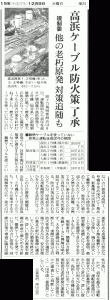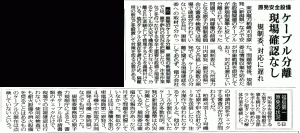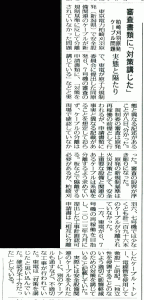Original Japanese written by staffer
The English below translated from the original Japanese by Heeday
The English translation edited by Rev. Dr. Henry French, ELCA
(Based on articles from the December 9th, 2015 edition of the Asahi Shimbun newspaper)
▼Click the image and read the caption.

Kansai Electric Power intends to extend the lives of Units 1 and 2 of the Takahama NPP, which are now more than 40 years old. The Nuclear Regulation Authority has been examining the case. One major issue there is fireproofing of the power cables, more than 1,000km (625 miles) in total length. Kansai Electric proposed to cover such cables with fireproof sheets, among other measures.
Japan’s new regulations on NPPs require fireproof cables. The two 40-year-old units in question, however, do not employ such cables. Kansai Electric, therefore, needs to take some measures to provide similar fireproofing. The power company applied to the Authority for permission to extend the two units’ lives by 20 years.
Kansai Electric has presented a plan both to cover some cables with fireproof sheets and to replace cables conducting high-voltage current with flame-resistant cables. An examination meeting of the Authority has approved most of such safety plans.
The two units at Takahama need to complete their examinations for life prolongation. Now, the greatest issue, fireproofing of cables, is almost solved. The final approval to the life extension of Units 1 and 2 is in sight.
The issue of power cables not being fire resistant can be found at many other old NPPs as well. Thus, many other old NPPs will have to resort to similar safety measures.
Actually, with this issue of fire proofing cables, Kansai Electric made a big “flamer” of itself before. To the measures it proposed earlier, the Nuclear Regulation Authority responded with very harsh criticisms, saying: “There is no evidence of safety,” and “Not trustable,” on May 26th, 2015.
(Quote from the relevant article of the Asahi Shimbun’s May 27th, 2015, edition.)
“In its examinations of whether or not to permit the restart of Kansai Electric Power’s Units 1 and 2 of the Takahama NPP, the Nuclear Regulation Authority, on May 26th, harshly rebuked—“There is no evidence of safety,” “Not trustable,” etc.—the power company’s claim that painting non-fireproof cables with some special paint can satisfy the required fireproof standard. At the examination meeting held that day, the power company said it had confirmed that covering up cables with fireproof paint or with fireproof sheets would provide enough fire resistance. To this claim, the examiners of the Authority responded with a harsh rebuke, saying: “The experiment data are too small in quantity and provide no proof. With such little data, we are unable to make an objective judgment.” The examiners also pointed out examples where some fireproofing paint, tried by some other NPPs, crumbled, saying: “Cable maintenance and control have been utterly miserable so far. How can we trust you when you say you will thoroughly tighten up your control of cables?” Kansai Electric replied repeatedly, “We will make more detailed explanations.”
Elsewhere, at TEPCO’s Kashiwazaki-Kariwa NPP (Niigata), some cables to the safety equipment were, against the new regulations, not separated from other cables. However, in the examination papers TEPCO submitted to the Authority for Units 6 and 7, the power company wrongly claimed that “some measures were taken for safety” with respect to the cables in question.
(From an article of the December 9th, 2015 edition of the Fukushim Minpo newspaper)
▼Click each image and read the caption.
The Authority’s examinations are a prerequisite to the restart of a NPP. However, the Authority did not expect an electric company to include an untrue statement in the application documents. Thus, the Authority did not confirm the state of the cables in question at the sites. This reveals serious limitations to the examinations conducted by the Nuclear Regulation Authority.
The new regulations for NPPs require that the cables to/from safety equipment be separated from the other cables. Boards or some other objects must stand in between those two types of cables. At Units 6 and 7 of the Kashiwazaki-Kariwa NPP, however, at least 296 cables in all were not protected by separation.
Still, the application for approval of the work plan, submitted in September 2013 by TEPCO, who wants to restart the two units, explicitly stated that “the two types of cables are laid down with separate cable trays and conduits,” and “we have taken measures to alleviate mutual interferences between the two types, keeping the two independent of each other.”
In reality, TEPCO did some faulty work, for instance, placing cables of different types in trays that also held cables to the safety equipment. The power company said, “We wrongly believed that we had taken the right measures. We did not confirm that sufficiently.”
The Authority, in August, chose Kashiwazaki-Kariwa’s Units 6 and 7 as priority units to examine, among all the boiling water reactors subject to inspection. (Fukushima Daiichi is another example of boiling water reactors.) The Authority, however, was unaware of this cable placement issue, until TEPCO reported on it in September 2015. Similar problems have been discovered at Unit 4 of Chubu Electric Power’s Hamaoka NPP and at Unit 1 of Hokuriku Electric Power’s Shika NPP.
At Chernobyl, some structural problems and human errors worked together to create one of the worst NPP accidents in human history. It is now evident that, prior to the disaster, the relevant parties gave precedence to economy over safety and covered up many wrongdoings.
On December 26th, 1985, the Soviets celebrated an anniversary of the nuclear power industry, and they hoped to finish off Unit 4 of the Chernobyl plant by then. To accelerate the building work, therefore, they replaced some inflammable heat-resistant material with a flammable one, which was one factor that helped spread radioactive substances.
Japan’s Nuclear Regulation Authority’s examinations can seriously affect the future of everyone in Japan. While pressure from the national government is affecting the Authority’s inspections and judgments as the government turns back to nuclear power, Japan’s general society is not responding as it should. To me, this looks like the calm before a deadly storm.


